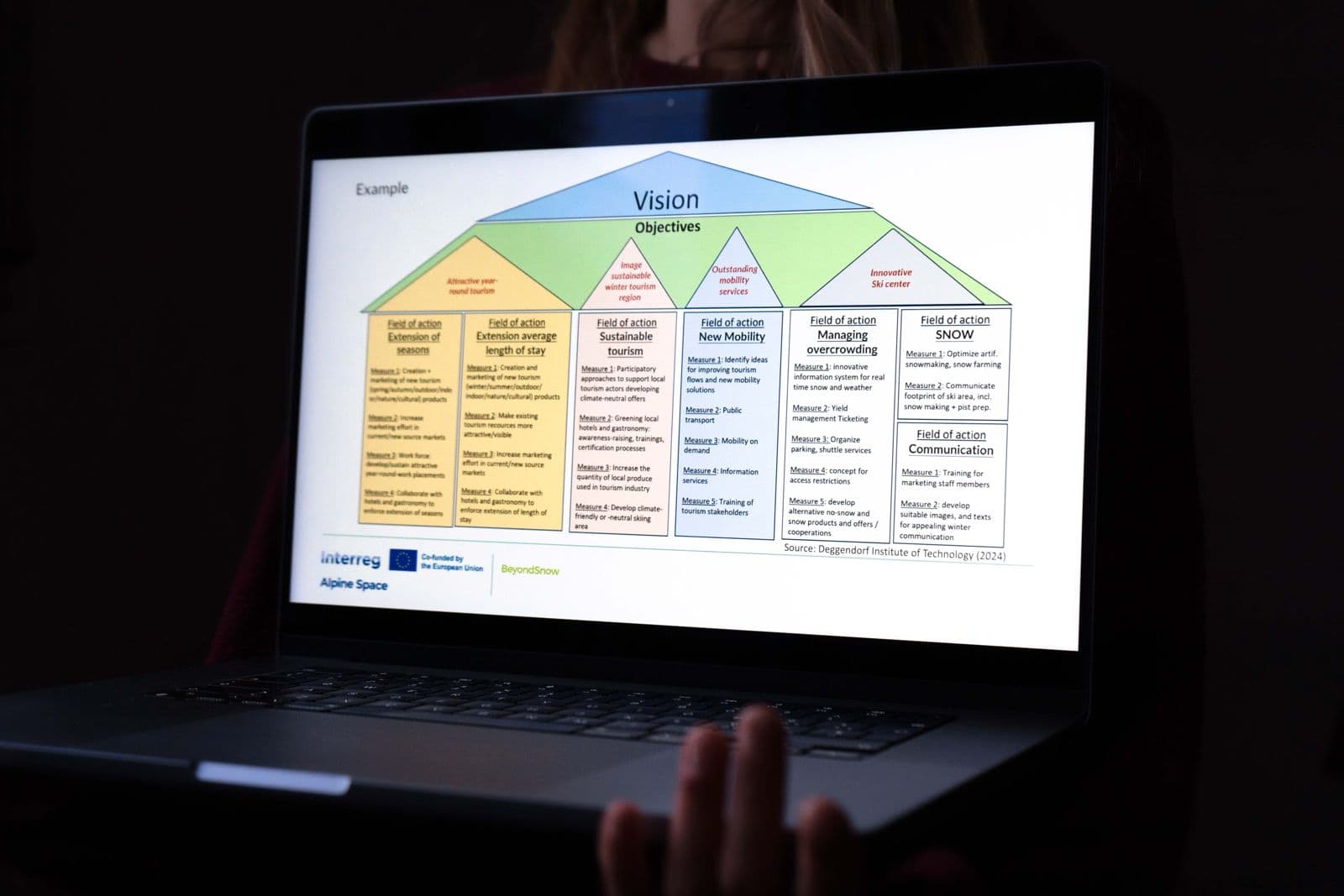Developing a Masterplan to Facilitate the Transition of Snow Tourism Destinations in Response to Climate Change With increasing disruptions from shifting weather patterns, snow tourism destinations face specific challenges such as lack of snow coverage, shorter snow seasons, increased dependency on technical snowmaking, shifts in tourism demand, abandonment and ageing of (ski) infrastructure, and rising investments. Against this background, a comprehensive masterplan is fundamental for these destinations to maintain the sustainability, resilience, and economic viability of tourism. As part of the Interreg Alpine Space project BeyondSnow, transition strategies are being developed for 10 specific Pilot Working Areas (PWAs) to strengthen the resilience of snow tourism destinations and their communities to climate change. These strategies are elaborated within co-design laboratories – innovative workshops held in each PWA – using a masterplan approach to address these climate change-related challenges. This article outlines the key steps in developing such a masterplan, providing a strategic framework to guide the transition process. The needs and concerns of various stakeholders, including representatives of the tourism industry and local communities, are addressed, to ensure that the resulting plans are tailored to the specific requirements of each area. Key Steps in Developing a Masterplan
- Identify Key Stakeholders
-
- Begin by listing all relevant stakeholders within the destination, including representatives from the tourism sector, politics and administration, non-profit sector, and local communities. Mapping out their roles, responsibilities, and available resources is essential for determining their influence and capacity to contribute to the transition process.
- Engage with stakeholders through interviews, forums, or online consultations to understand their aspirations, concerns, and perspectives. This fosters trust and acceptance, which are decisive for the success of the masterplan.
- Conduct a Strategic Analysis
-
- Develop a SWOT (Strengths, Weaknesses, Opportunities, Threats) analysis to capture the key strategic issues that need to be addressed. This analysis will highlight the critical challenges and potential outcomes for the transition to viable tourism.
- Present these findings at a public meeting to gain feedback and agreement on the priorities. This step is necessary for ensuring transparency and accountability.
- Secure Stakeholder Support
-
- Obtain a formal support from stakeholders for the development of the masterplan. Without their commitment, the masterplan may face resistance or be disregarded during implementation. This commitment can be established during public meetings or consultations where the key issues are discussed.
- Develop a Viable, Multi-Year Tourism Masterplan
-
- Based on stakeholder input and strategic analysis, create a masterplan that outlines well-defined objectives, roles, responsibilities, and timelines.
- The masterplan should be concise, with a clear vision that reflects the aspirations of stakeholders. It must be accessible and comprehensible to all parties involved to secure wide recognition and respect.
- Communicate and Promote the Masterplan
-
- It is highly important to effectively communicate the benefits of the masterplan to all stakeholders. This can be achieved by emphasising the long-term advantages for the destination, including economic growth, environmental sustainability, and improved community well-being.
- Embedding the masterplan in local governance and policy frameworks is equally important. This guarantees accountability and prevents stakeholders from questioning its validity in the future.
- Assign Responsibility
-
- A strong and accountable management structure is essential for successful implementation. Identify an agency or partnership responsible for overseeing different elements of the masterplan. This entity should possess the necessary expertise, resources, and commitment to drive positive changes.
- Encourage Continuous Dialogue
-
- Encourage open debate and feedback throughout the masterplan development and implementation process. Engaging business, community, and tourism stakeholders from the outset fosters inclusivity and enables the incorporation of diverse perspectives.
- For stakeholders who initially resist the plan, maintaining ongoing communication is fundamental. Address their concerns and demonstrate how their interests are being considered and reflected in the masterplan’s measures.
- Reassess the Masterplan Periodically
-
- Treat the masterplan as a dynamic, evolving document. Periodically review and adjust the plan to account for changes in the destination’s tourism economy, environmental status, and community needs.
- Regular assessment ensures that resources are being used effectively and that the plan remains relevant in addressing emerging challenges.
A carefully designed masterplan is central for snow tourism destinations to deal with the uncertainties posed by climate change. By engaging stakeholders, conducting strategic analyses, and maintaining flexibility in implementation, these destinations can foster sustainable tourism practices that protect the environment, the local economy, and the well-being of the local community. Continuous dialogue, periodic reassessment, and strong leadership are likely to further support the transition towards climate resilience. The transition strategies developed in the PWAs will be ready for implementation in 2025, offering a tangible path forward for addressing the manifold challenges of climate change.



